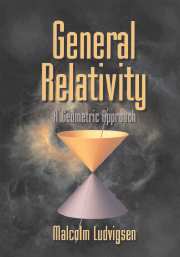Book contents
- Frontmatter
- Contents
- Preface
- PART ONE THE CONCEPT OF SPACETIME
- PART TWO FLAT SPACETIME AND SPECIAL RELATIVITY
- 3 Flat Spacetime
- 4 The Geometry of Flat Spacetime
- 5 Energy
- 6 Tensors
- 7 Tensor Fields
- 8 Field Equations
- PART THREE CURVED SPACETIME AND GRAVITY
- PART FOUR COSMOLOGY
- Solutions and Hints to Selected Exercises
- Bibliography
- Index
4 - The Geometry of Flat Spacetime
Published online by Cambridge University Press: 04 June 2010
- Frontmatter
- Contents
- Preface
- PART ONE THE CONCEPT OF SPACETIME
- PART TWO FLAT SPACETIME AND SPECIAL RELATIVITY
- 3 Flat Spacetime
- 4 The Geometry of Flat Spacetime
- 5 Energy
- 6 Tensors
- 7 Tensor Fields
- 8 Field Equations
- PART THREE CURVED SPACETIME AND GRAVITY
- PART FOUR COSMOLOGY
- Solutions and Hints to Selected Exercises
- Bibliography
- Index
Summary
In this chapter we shall consider the intrinsic geometric structure of flat spacetime M. In particular, we shall use the results of the previous chapter to show that M has a natural physically defined affine structure (i.e., the notion of a displacement vector makes sense) and, most importantly, that the space of displacement vectors possesses a natural, physically defined metric.
Spacetime Vectors
A spacetime displacement is simply an ordered pair of spacetime points. We write OP = - PO and OP + PQ = OQ. If P lies inside N(O), the null cone of O, we say that OP is timelike, in which case O and P lie on the world line of an observer or a massive particle. There are two types of timelike displacements: if P lies in the future of O (according to an observer whose world line passes through O and P), we say that OP is future-pointing otherwise, of course, we say it is past-pointing. If P lies on N(O), we say that OP is null, in which case O and P lie on a null ray or the world line of a massless particle. Again, there are two types of null vectors, future-pointing and past-pointing, depending on whether they lie on N+(O) or N−(O). If OP is neither timelike nor null, that is, if P lies outside N(O), we say that OP is spacelike (Fig. 4.1).
For a timelike displacement OP, the points O and P lie on a world line l with proper time t. If Q also lies on l and t (Q) – t (O) = a[t (P) – t (O)], we write OQ = α OP.
- Type
- Chapter
- Information
- General RelativityA Geometric Approach, pp. 27 - 39Publisher: Cambridge University PressPrint publication year: 1999

